|
Monday, March 10, 2008
Progress Notes
Elmer (Dub) Brown (photo 01) has
been very helpful these past months in supplying me with information about people and
events in the area where he grew up between Eldon and Tuscumbia known as Ginger Ridge
through which Brown Road passes.
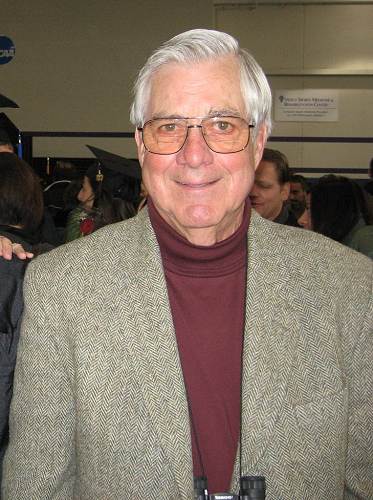
01 Elmer Brown
His mother, Mrs. R.S. Brown, who was from Scotland, was well known to me since
the Brown family attended the Presbyterian Church in Tuscumbia where my family also were
members. Elmer was just enough older than me that our paths didn't cross much before he
left the area, but I remember well his mother and two sisters, Marie Brown and Kathleen
(Brown) Martin. Kathleen was married to Frank Martin, who was a nephew of my grandfather,
Madison Bear. I especially enjoyed reading Dub's essay about the Ginger Ridge one room
school which was uploaded on this page a couple of weeks ago. Several other readers also
liked it and emailed me to tell me so. Recently, Elmer sent me an essay concerning his
first experiences as a young person in dealing with death and dying. I found the essay
very interesting, not from a maudlin point of view, but because it highlighted some of the
differences in how people dealt with illness, death, and funerals years ago as compared to
current practices. Recently, I finished reading the book, "Family Memories," by
Ila Hill (photo 02) in which she told
the story of the tragic death of her ninth child, Judith Ann, which occurred within a few
months of her birth.
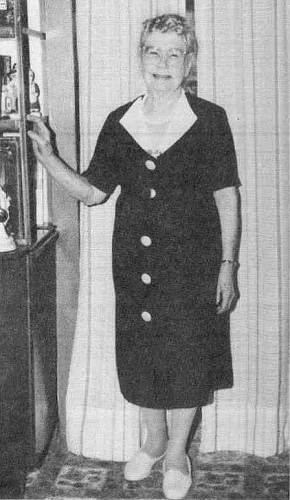
02 Ila Tucker Hill
Just coincidentally, because Elmer and I hadn't discussed the story, Elmer
included his memories of this sad event in the narrative about death that he sent me. I
found the narratives of this somber story by two different people who were involved, Ila
and Elmer, while heartbreaking to read, was very moving and for that reason I wanted to
share it with the readers of this web page. First, I will copy here the story of the death
of baby Judith as told by her mother, Ila Hill:
August 2nd 1948 was a very happy day for Bert and me
(photo 03).
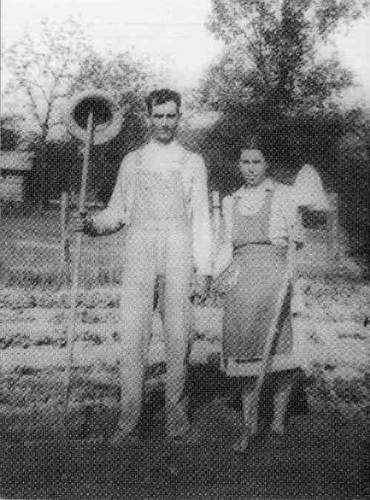
03 Bert and Ila Tucker Hill
Our ninth child was born, another beautiful baby
girl! We named her Judith Ann (photo 04), but then as now, when we talked of her, she was our Little Judy.
Such a sweet quiet baby, never crying. At first I thought that was because she felt so
good there was no need to cry. But as days and weeks passed we finally realized our
beautiful baby could feel pain, but couldn't make a sound. What a terrible shock that was!
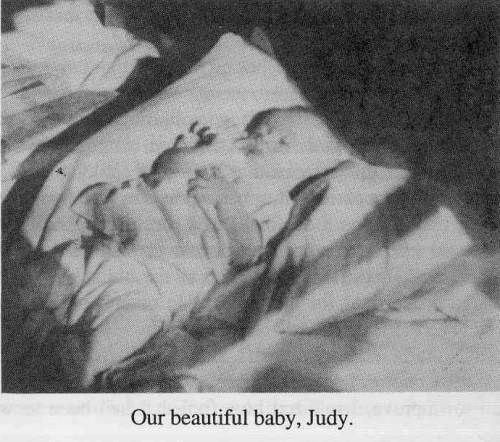
04 Baby Judith
But we were thankful she could hear, for it wasn't
long till she would turn her little head toward the kitchen, with a pleased expression on
her face, when Bert came into the kitchen and spoke. So we knew she had learned the sound
of his voice!
She seemed slow about noticing things, but I reminded
myself that some children are slower about doing some things than others, and there was
probably nothing to worry about. Yet, still I wondered. When we'd put a rattle in her
hand, she'd hold it but showed no interest in it. So as weeks passed we finally realized
our precious Little Judy was also blind!
What a terrible tragedy for a baby to endure! When she was
six weeks old, I took her and three year old David with me to St. Louis so I could be with
Dorothy when her baby was born. A healthy, active, crying baby boy! So much different from
our quiet little Judy. I'm not sure, but seeing him may have been when I became more
concerned about our baby, realizing how far behind she was in every way, compared with
their baby, Dennis Lane.
While reading this, some may wonder why we weren't taking
her to doctors, trying to learn if something could be done for her, as most would now. But
as I've said so many times before, everything was so much different then, most people
tried to accept things of that kind and do the best they could for them. Over all these
past forty some years, so much has been learned about all parts of the body, that can
change the course of many things, but even now, I feel certain that little, if anything,
could be done to alter a case like hers.
It will always be a mystery why such things happen. Why
couldn't she have been as perfect in every way as all the others were? Was it something I
did or didn't do? Could it have been because she was a change of life baby when my health
had been so bad, and in a weakened condition? I will never know. But she did seem to be
healthy in all other ways, and she didn't even have the colic as much as the others had.
She was content to lie on the bed with a peaceful expression on her face, until she was
hungry. I can't remember how I knew that, but when I let her nurse, she looked happy
again!
The months had slipped by, October, November, December and
half of January. At times I could see she was having pain, but it would soon pass, and she
was peaceful again. That wasn't unusual for babies that age. She could have been cutting
teeth, which can be very painful for most babies who act the same way.
I held her more than usual, rocking and singing, trying to
comfort her as much as I could, and worried, for the painful expression came more often
and finally became so severe she turned her head from side to side as she lay in my arms.
I felt certain we should take her to the doctor, but the weather was so cold and the roads
covered with snow and a glaze of ice, a terrible time for anyone to be out, and especially
a baby. Then too, we would have to ask a neighbor to take us. So we waited and worried,
doing all we could to make her comfortable, until finally we knew we had to go.
I don't remember who took us, but probably Elmer Brown or
Marie. I remember when we got there she looked the picture of health, no pain. She was so
beautiful in her pretty blue dress that Alice had bought for her. But the second the
Doctor looked at her, a strange look flashed across his face, but he didn't say anything
so I could only guess why. I explained that there were times when she turned her head from
side to side with a look of pain on her face, but she couldn't make a sound! He checked
her, but didn't say anything that could help me to understand why. He was a man of few
words, especially when explaining about a patient, and now I can't remember what he said,
but I had the feeling when we left, that he didn't find much to be alarmed about, but
still I worried.
That was sometime during the afternoon, and late that
evening she got so bad I was sure she was dying. We sent one of the children to the Browns
to call the Doctor, who came the five miles in record time. Mrs. Brown and Marie had come
to help. Little Judy was still alive, but when the doctor saw her he said he'd have to
take her to his hospital which was in Tuscumbia. It was then that I did something that I
have never been able to understand, I said, "Can I go too?" The Doctor flashed a
strange look at me, and said, "No, Mrs. Brown can go." I felt so strange; it was
as if someone else had asked that question. Normally no one could have kept me from going,
holding my baby, doing everything I could for her. But somehow I wasn't myself! As soon as
the Doctor, Mrs. Brown, my baby, and Bert left, Marie took over, she turned the quilts
back on the bed and told me to lie down. She blew the kerosene lamp out, and took the
children to the kitchen, so I could be alone. By that time it was night so the room was
dark and quiet. I didn't want to go to sleep, I didn't even want to lie down, but I did
because Marie had said to. I knew my precious baby was dying and still I couldn't cry. As
always the tears were locked inside, and I felt I was on the verge of losing my mind!
Marie quietly opened the door a time or two to check on me, but I didn't move, pretending
I was asleep. But I can imagine she must have wondered how I could at a time like that,
and she would have been right. I didn't know it then, but learned later that she had
washed the dishes while they waited. Later I heard she had said she never washed so many
dishes in her life! It probably wasn't that there was so many, but the dried food on them
made it so hard, we seldom had enough water to soak the dishes and since I had let the
house work go while I took care of the baby, I'm sure things were quite a mess! Dear
Marie, inside that tough sounding outside, she had a soft heart and kindness that caused
her to be a wonderful person who would do anything for anyone in need.
How I wish she could have known how much I appreciated all
she did for us that night!
I have no idea how long Elmer, Mrs. Brown and Bert were
gone, but when they came back, I learned my darling baby had died in Mrs. Brown's arms a
few minutes after they left the house. All I know now of that night, and the following two
days, was told me recently by a good friend, Mamie Harbison. She is the only one left, who
helped through that terrible time.
That week we had some of the worst weather of the
winter… snow and a heavy coat of ice. When Mamie heard a car trying to climb the big
hill north of their house she went to their ash pile and carried buckets of ashes to
scatter on the road, then helped push the car on up the hill. She was shocked later when
she learned the ones in the car were Elmer, Mrs. Brown, Bert and our baby, who had just
died!
Since the doctor had gone out first, I'm sure they went on
to the hospital, and then the heart breaking trip to Eldon, to the Phillips Funeral Home,
and leaving her little body there. How I wish I had been there with Bert to share his
grief. How alone he must have felt! But in my condition, I might not have been a help.
Mamie also tells me when Helen Phillips (photo
05) brought our little Judy's body back in the
casket to our house the next day (a custom at the time), Helen's car got stuck in front of
Mamie's house and she tried to pull it out with her truck but couldn't. So she took Helen
to Tuscumbia to get someone from a garage to pull the car out.
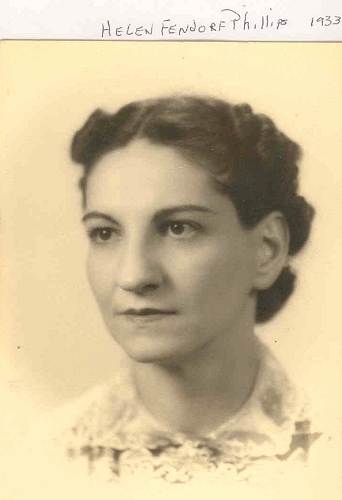
05 Helen Phillips - 1933
Then the day of the funeral, the roads were as bad
or worse, for no one could drive up our hill to the house, so we all had to walk down to
the road and the waiting cars, with the danger of falling at every step. That part is all
I remember of that day. My mind has blocked out everything. Maybe in a way that is best,
but still I wish I could remember.
Mamie also had to put ashes on the road that day so we
could get up the big hill.
Dear Mrs. Brown, having gone through all the trials of
womanhood and the mother of six children, all grown at the time, she could see the things
in me that my family couldn't.
Over a long period of time, when she saw me, she kept
insisting I should see a doctor. But I kept putting it off, hoping Bert would see the need
and tell me to go. Of course he didn't know of Mrs. Brown's concerns and as the old saying
goes, "He couldn't see the trees for the forest." In other words, seeing me
everyday he didn't realize my condition.
But finally when again, Mrs. Brown very firmly insisted
that I must see a doctor, I did. Then a few weeks later, when my health began to improve,
I realized how foolish I had been to wait so long. In my own mind, I gave Mrs. Brown
credit for my sanity and life, for I don't think I could have gone on much longer as my
health had been for so long. How I wish I could tell her now how much I appreciated all
she did for me over all the years we were close neighbors and even before, when we lived
on the Demott farm, and she rushed over the hills in the cold to help save our baby
Dorothy, when it seemed she had stopped breathing! I'm sure the weeks and months, as they
passed, were even harder for Bert than for me. For he was outside alone as he worked,
except on weekends, for Harold and Bob were in school. So there was no one to talk with or
distract his thoughts from the death of our Little Judy, unless he and Ed Harbison were
cutting and hauling wood. David wasn't old enough to go to school, so he was at home with
me, so that was a help.
It took a long, long time for me to think of her death as
being for the best. But when I finally thought of what her life would have been, all her
struggles and heartaches she would have had to endure, I knew it was best for her. So I
finally accepted it enough I could enjoy my everyday life and family as before, but the
hardest part then was seeing another baby and holding it. That gave me a heavy heart, and
I don't think I have ever overcome it.
Now to the narrative by Elmer in which he discusses a number of his early experiences
with death of those he knew in the neighborhood, but most interesting and coincidentally,
as I mentioned above, his involvement with the tragic death of Ila and Bert Hill's baby
daughter, Judith:
Childhood Impressions of Death
Elmer Brown
I suppose my earliest recollection of death was when my
father died. That was in the spring of 1934 so I was about two and a half at the time. I
can vaguely remember him lying in the casket in our front room and being lifted up to look
at him. I don't remember any reaction or that I even realized why he was lying there like
that. I have been told by older members of the family that I burst out with, "Oh,
listen to the pingee", when the pianist started playing the first hymn during the
funeral service. It probably brought smiles to a few faces but I doubt if those
straight-laced Presbyterians would have allowed themselves to chuckle.
The practice of having the body in the family home for
visitation was not uncommon in those days. I suppose it had started in the times before
the use of undertakers had become prevalent. I'm sure it also had to do with the fact that
getting to and from the funeral home was difficult and time consuming in the days before
cars and good roads. When that did happen, the custom was that several men would sit up
with the body until the funeral. These were usually friends, neighbors and members of the
extended family. I'm not sure of the rationale for this practice but I do remember my
brother-in-law, Frank Martin (photo 06)
doing it a few times as I was growing up.
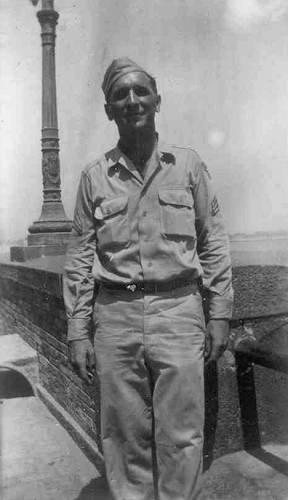
06 Frank Martin
There were also some people who had an aversion to
using an undertaker for one reason or another. I'm sure it was a matter of cost in some
instances since everyone was dirt poor. I can remember a couple of times where the
neighbors came to get mother to help wash and dress a woman's body because there were very
strong feelings that no man other than her husband should see her unclothed body.
Obviously, there was no embalming done in these cases so the time lapse between death and
the funeral was relatively short, particularly in the summer time.
It was also the usual custom that family and friends would
dig the grave. Of course, it was all done with picks and shovels since tractor mounted
backhoes were not available yet. Miller County has very thin topsoil, which is typically
underlain with hard pan clay and/or solid rock. The clay could usually be penetrated
slowly and painfully with the hand tools. The rock was another matter. Several holes had
to be drilled, using steel spud bars and sledges, and then dynamited. Hopefully whoever
set up the charge knew what he was doing so that the rock was broken up but yet a huge
crater didn't result or chunks of rock shower the countryside. The broken up rock then had
to be removed from the hole and very likely the process had to be repeated until the
appropriate depth was reached. It wasn't too unusual for there to be concern that the
grave wouldn't be done in time for the funeral, in which case the community would rally,
extra men would show up and work would continue through the night by light of kerosene
lanterns.
I can only remember participating in one grave digging
though I don't suppose I put in more than a couple of hours. Frank's Aunt Sadie Bear
(photo 07) had passed away and since she was a member of our church I went to
help out for a while. I know that we had to contend with both the hard pan and rock, but
in addition the heat, since it was mid summer. I didn't have anything to do with the
dynamite but it was the biggest bang I had heard until that time and quite exciting.
Bear.jpg)
07 Sadie (Abbett) Bear
I can also remember one death, a suicide, in the
neighborhood, which really got my attention for some reason. I was probably about nine or
ten at the time. A man named Jackson who lived on Highway 52 towards Tuscumbia had shot
himself using a shotgun. Someone came to get mother to help clean up the mess since he had
been in one of the bedrooms when he did it. I don't know if the person who came was
totally indiscrete in telling what had happened with me around, or whether I had been nosy
and managed to be where I could hear all the gory details. I suspect it was the latter.
Regardless, my vivid imagination took over and when it came time for bed I was very upset
and not able to get to sleep until mother was brought home. I don't recall what my
thinking was other than I had this idea that something was happening to my mother and I
wouldn't be reassured until I saw her myself.
One other instance of death had a lasting impression on me
as a teenager. I was at least sixteen since I was driving.
Bert and Ila Hill, who lived about a quarter of a mile up
the road, had a baby who was sick. In those days of limited money and no such thing as
medical insurance, you didn't go to the doctor unless you were really sick. And when the
weather was bad, travel was precarious since back then very few people had cars. But one
evening Harold Hill, who was my age, knocked at the door. Ila was worried about the baby
and wanted mother to come take a look at her.
We had known the child was sick and mother must have
figured she had gotten worse because she and Marie didn't hesitate to put on their coats
and boots and head out the door. As they were leaving they told me to bring the car as
close to the Hills' house as I could.
That was easier said than done. We had gotten several
inches of snow, then rain and then it had turned cold. The snow and everything else was
covered with solid ice. Trees, power lines and phone lines were down all over the country.
The creek crossing leading into the house was frozen, but not solidly enough to support
the car so you broke through in the middle. The only way to get across was to hit it
fairly fast, which meant there was quite a splash, which meant the brakes got wet, which
meant that if you didn't drive quite a ways riding the peddle they froze. The only way to
thaw them was to pour hot water on and then get moving before they froze again.
Well, I managed that and got up to the Hills in half an
hour or so. Mother's first order was, "Go to Tuscumbia and get Dr. Humphreys (photo 08) out
here as soon as possible".
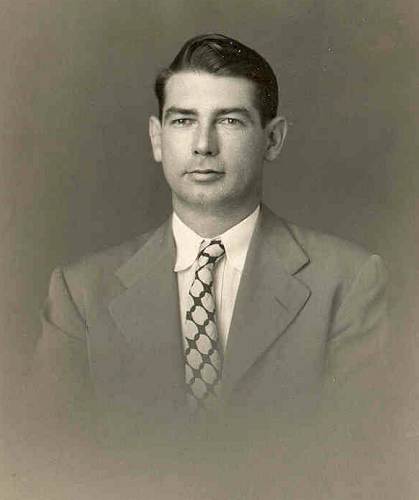
08 Dr. Marshall Humphreys
I knew I would never make it up the hill by Ed
Harbison's without some help since it was covered with ice and you had to slow down to
cross the rough culvert at the bottom or risk a blowout or broken spring. I told Harold
and his younger brother, Bob, to grab a shovel and a bucket of ashes. When we got to the
base of the hill they got out and went part way up with the ashes. I started up and when
the wheels started spinning they threw ashes in front of them. We were finally able to get
to the top and from there made our way carefully into town.
Fortunately, Dr. Humphreys was home and said he would be
right out. We started back, driving at what I thought was a prudent speed, considering
that the highway was a solid sheet of ice. We weren't three miles out of town when he
passed us like we were sitting still. By the time we covered the remaining three miles to
the Hills' house he had assessed the situation, loaded Bert, mother and the baby in his
car and was on the way back to his office. Unfortunately, it was too late. The baby died
in mother's arms before they got there.
Doc brought them all back to the house. No one had a phone
yet so it was now necessary to get the baby's body to the undertaker in Eldon. We put the
body in the back seat and Bert and I headed for town. We had to use the ashes again to get
up the hill but made it without further incident.
Once in Eldon, we delivered the body to Phillips Funeral
Home and then went to the telephone office to call the three older girls who were working
in St. Louis. This was well before the days of microwave and all circuits were carried on
cable and open wire, usually above ground. Due to the ice, everything was down and only
emergency communications were going through by means of Ham Radio patches.
Bert was pretty deaf so wasn't able to hear well enough
and couldn't quite get the hang of saying "over" when he would finish a sentence
and was ready to let the other party talk. So, I had the unpleasant task of telling Alice,
Dorothy and Frieda that their baby sister had died.
The next day I stayed out of school and took Bert to
Tuscumbia to make arrangements for a cemetery plot and then to Eldon to meet the train
bringing the sisters and Ila's brother and wife in from St. Louis.
It was a hectic 24 hours but as I look back I did a lot of
growing up in that short period of time.
Thanks Elmer.
In Elmer's narrative he mentioned that he helped Frank Martin dig the grave of Sadie
Bear. Sadie was my grandmother and I was old enough to remember her death and funeral very
well. She suffered with Parkinson's Disease for the last twenty years of her life, finally
passing away at the age of 62. I remember that the casket with her body was placed in the
living room of Grandfather Madison's log home in Tuscumbia where many people came the day
before the funeral to greet family members (photo
09 of Sadie and Madison in front of log home).
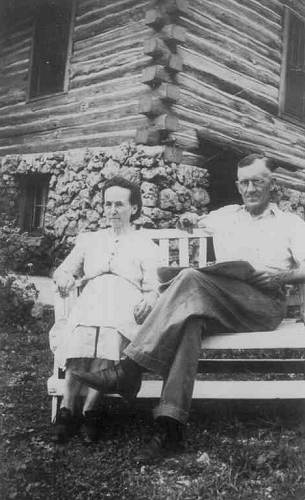
09 Sadie and Madison Bear - 1946
I was short enough that I had to stand on tiptoes to look inside the casket. I
was encouraged to do so by my mother because she wanted me to understand early on that
death and dying are a natural part of the life of all God's creatures. I was young enough
that I don't remember great sadness because I didn't know or understand that I wouldn't
see my grandmother again. I remember that the Presbyterian Church the next day was very
crowded. A lot of people knew her because she had worked in the family general store in
Tuscumbia for many years.
Although any discussion of the subject of people dying, wakes and funerals usually is
somber and serious, occasionally the eccentricities of some people can add a note of
humor, even in spite of the general nature of the subject itself. For example, on our own
web site two well known stories have been uploaded which exemplify what I mean. The first
story has been discussed recently on this page concerning the famous Jim Skinner tomb. For
a review of this story go to the following page on our web site:
http://www.millercountymuseum.org/articles/skinner.html
The other well known example in Miller County of unusual circumstances involving a
death and burial has to do with the burial of John Wilson. Go to this page on our website
to read about that:
http://www.millercountymuseum.org/articles/wilsoncave.html
Although the tomb of James Skinner is pictured on the first site above, the story of
John Wilson's burial does not feature a picture of the cave where he was buried so I will
show it here (photo 10):
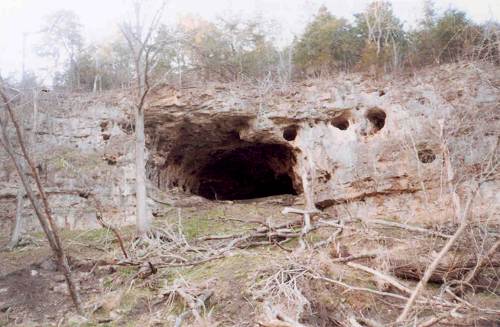
10 Wilson Cave
Finally, a discussion of traditions surrounding death and burials in Miller
County would be incomplete if something is not included about the history of Native
Americans in this area. Many caves in the Ozarks contain artifacts of Indian life dating
back thousands of years in the past. In some of the caves evidence of Native American
burials is present. For a couple of years quite a while back (1961-1962) I had a summer
job as a cave guide in Indian Burial Cave (photo
11 of office) located on D road two or three miles down river from Bagnell Dam.
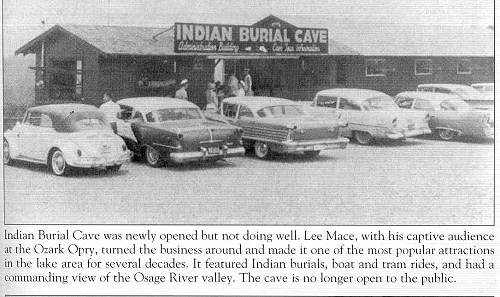
11 Indian Burial Cave
Many will remember the numerous double arrow signs advertising Indian Burial Cave
placed along the roadsides which were quite ubiquitous in most of Missouri some forty five
years ago and thereafter (photo 12 of sign).
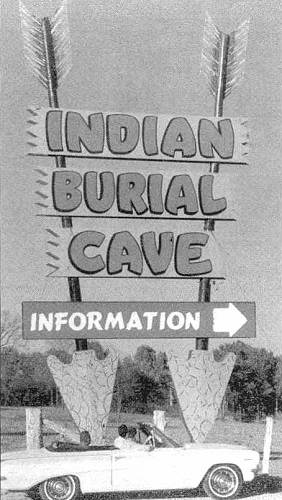
12 Indian Burial Cave Sign
James Atkisson owned the cave which was located on his farm. One day he
discovered some human skeletal bones which, after appropriate investigation, were
determined to be the remains of Native Americans from the Woodland period going back about
fifteen hundred years.
Lee Mace and Al Lechnir leased the cave from Mr. Atkisson and opened it up for
public tours. Lee, who was a Miller County native, was very kind to many of us younger
people giving us summer jobs in one or the other of his various enterprises at the Lake
and I was fortunate enough to be given the cave guide job. During my two summers working
there experts from the Archaeology and Anthropology departments of the University of
Missouri investigated the burials and artifacts found in the cave. The archaeological
project was directed by Dr. Carl Chapman, probably the most well known archaeologist
produced by the University of Missouri. Much of what is known about the historical and
archaeological record of Native Americans of Missouri is owed to Dr. Carl Chapman. Chapman
dedicated his life to discovering Missouri's history and prehistory. In 1986, he was
researching the Rogers Shelter area in the Osage River Basin when he established what he
estimated to be an 11,000 year timeline from about 10,000 B.C. to about A.D. 1,000 for one
civilization in Missouri. The discovery is one of the longest cultural sequences found in
this area of the country. During the time I was a guide at Indian Burial Cave at least one
archaeologist or anthropologist from M.U., usually a doctoral candidate, was on site in
the cave daily who was very willing to talk with members of the tours about the burials in
the cave. The custom of burying artifacts and personal articles of the deceased with the
body seems to have been prevalent even as far back as these early inhabitants of the
earth. The thing I remember most about the archaeologists was the care with which they
excavated and retrieved artifacts for further study while at the same time preserving the
burial site out of respect for the dead.
Dwight Weaver, who is a member of our museum committee, has written six books about
Missouri Caves.
Before ending this section about Native American cave burials I would like to relate an
experience I had one day when I was guiding at Indian Burial Cave which almost ended up
adding me to the list of the dead in that cave. We guides had been instructed to be very
respectful and serious when guiding guests through the burial site although later through
the rest of the cave we were given latitude to entertain and offer some light hearted
comments of a general nature to make the tour fun. I had just finished telling a joke or
two when I came to the part of the tour where I was supposed to shine an ultraviolet light
on the cave wall to illuminate some minerals. On this particular day, the rubber cover for
the metal rod on which the light was fixed had dropped off. Being somewhat naïve at the
time concerning the danger of the combination of electricity and the damp environment of a
cave I paid little attention to the fact of the uninsulated handle and grabbed it tightly
to point the light. Suddenly, I felt a painful vibratory sensation beginning with my
clasped fingers around the rod and quickly passing up my arm and then into my entire body.
I fell down to the cave floor in front of about thirty people who just a minute before had
been laughing at one of the jokes I had told. On the floor of the cave I found I couldn't
talk or move…I was paralyzed, yet my arms and legs were convulsing. And to make
matters worse, more than a few of the members of the tour thought my fall and shaking body
were some kind of bizarre joke the result of which was that, although I couldn't talk to
plead for help, I amazingly heard some of them laughing. In my mind the preposterous
thought occurred that people were laughing at my imminent death! Fortunately, one of the
members of the tour group who understood what was happening swung his hand quickly and
forcefully against the electric cord thereby disconnecting it from the outlet.
Immediately, I was relieved of the convulsive uncontrolled movements of my arms and legs
and I was able to arise from the floor. I would say that on that particular day the tour
group would have had a lot more than archaeology to talk about as they reminisced about
their tour of Indian Burial Cave!
I am planning to upload onto this page in the near future an article about Miller
County Caves. One of my primary resources will be Dwight Weaver to whom I referred above.
As I mentioned, Dwight has written six books about Missouri Caves, his most current book
being Missouri Caves In History and Legend. University of Missouri Press -
Columbia, Missouri 65201
This book is absolutely fascinating, replete with anecdotes and stories having to do
with caves of Missouri as well as Miller County. Although Dwight can discuss in minute
detail things archaeological and geological you won't find this book to be one that bores
you with scientific terminology; it is a book which truly entertains and I recommend it.
It is from this book that you can learn more about Native American cave burials in
Missouri.
Two of the photos of Indian Burial Cave displayed above came from two other books of
Dwight's:
History and Geography of Lake of the Ozarks Volume I
Osage River Trails
38 Village Marina Rd
Eldon, Mo. 650261171
And:
Lake of the Ozarks: Vintage Vacation Paradise
Arcadia Publishing
3074 N. Lincoln Ave. Suite 410
Chicago, IL. 60657
If you would want to purchase books directly from Dwight you can contact him as
follows:
Phone: 573 365 1171
Email: dweaver@socket.net
We were very happy to receive the donation of a load of rough sawn oak (photo 16) from Martin Sawmill of
Russellville this week (photo 17). The
wooden planks will be used to create the facades of the old time store fronts and cabins
which we are placing in our museum for displays.
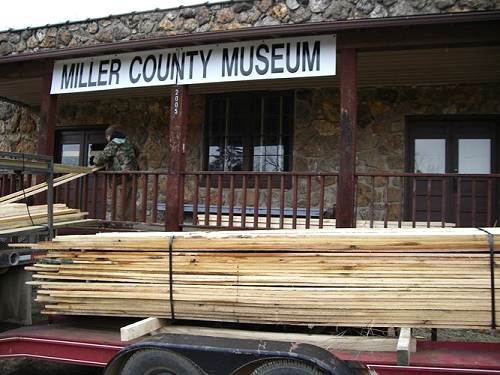
16 Martin Sawmill Donation
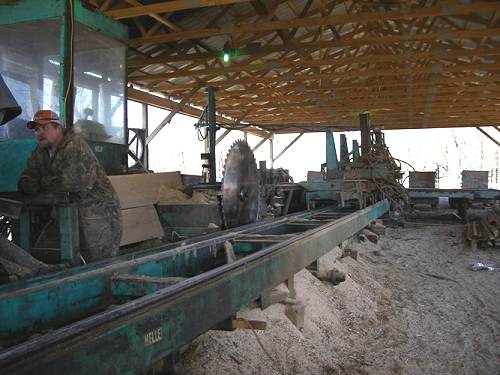
17 Martin Sawmill
This sawmill is one used by our museum building renovation supervisor, Paul
Holder of Eldon, who has been building homes and business buildings in the area for almost
fifty years. The mill is owned by the Martin family (photo 18) who came up to this area from Bunker, Missouri two
years ago to take advantage of all the logging that occurs here due to the abundance of
our oak forests.
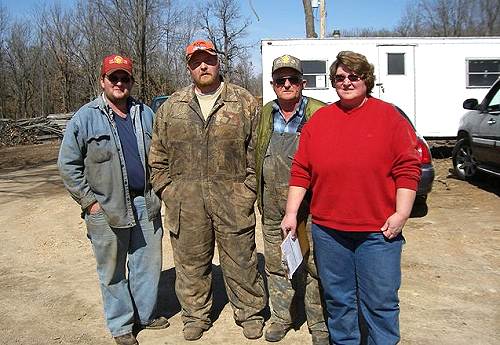
18 Charlie Jr., Bill, Charlie Sr. and Joyce Martin
Charlie Martin has been in the logging business all his life. He remembers when
horses were used to pull the logs to the mill and when cross cut saws were used to cut the
trees. My father ran his own saw mill to cut up cedar logs and work up cedar lumber for
the cedar novelty business he and his two brothers ran. I remember that saw mill which was
located near the old Pickens Home (later the Humphreys Hospital) in Tuscumbia. So when we
went over to get the lumber which the Martins' had so generously donated I was reminded of
how careful you had to be when working with those big heavy logs and that big saw blade (photo 19) which could rip them up.
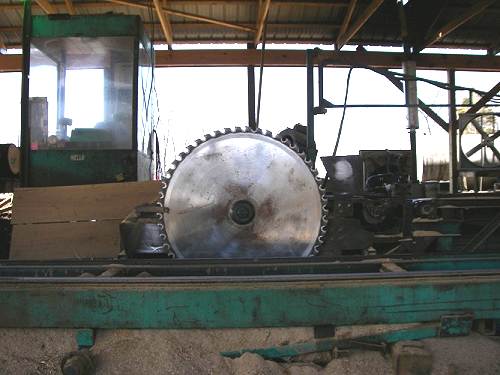
19 Big Saw Blade
One thing you need to be careful about is running the saw blade into some metal
buried deep in the log. That happened to my cousin Tim Pryor once when he was planing a
good sized cedar log and got into a mule shoe (photo
20) which could rip them up.
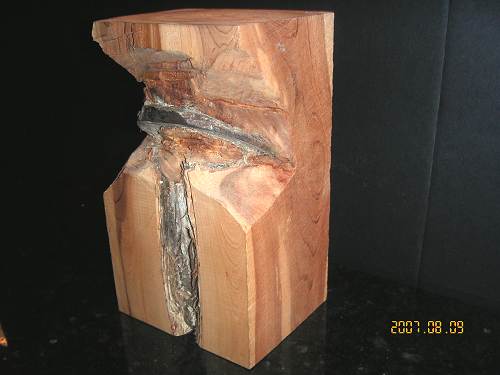
20 Mule Shoe In Cedar Log
The Martins are pretty busy people; logs were stacked all around waiting to be
worked up (photo 21).
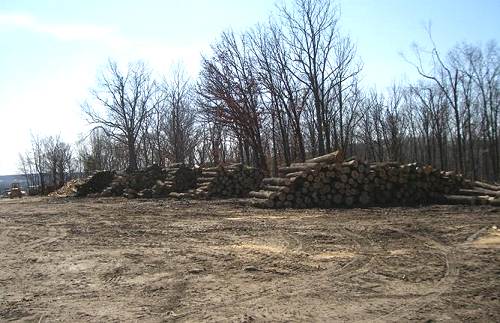
21 Stacks of Logs
A classmate of mine, Wes Horton (who owns the Red Oak Café in Tuscumbia) takes
logs to the Martins' occasionally. Some of the oak is cut into planks (photo 22 and photo
23) for the charcoal industry but most is cut up into boards for the steel
industry which uses them for cross outs or cants to stack their steel products up and off
the ground (photo 24 of stacks of boards).
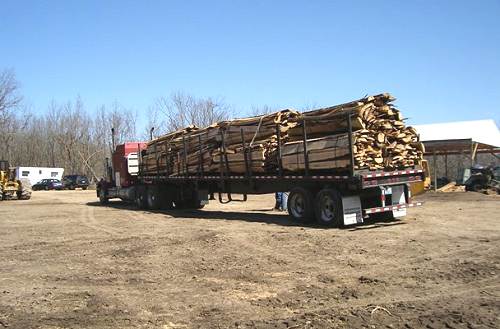
22 Charcoal Planks
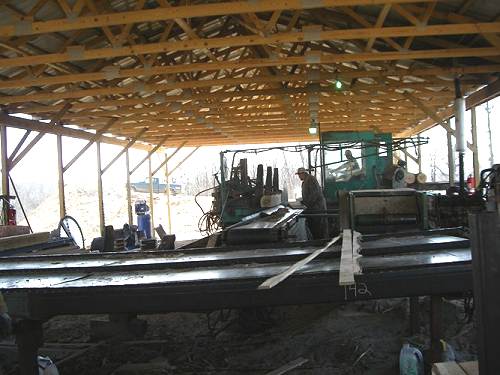
23 Cutting Planks
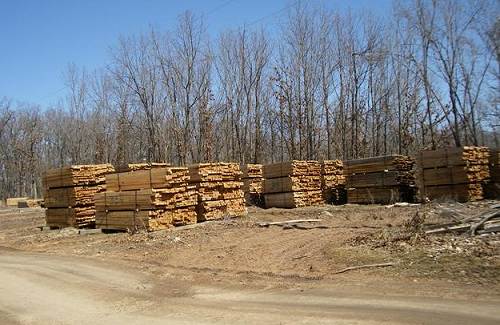
24 Lumber Stack
My cousin, Max Pryor, for a number of years, managed a charcoal manufacturing
company in Salem, Missouri and he told me that he remembers receiving quite a bit of oak
from Charlie Martin back in those days some twenty five years ago. Charlie is well known
in the logging industry. I thought it was very nice of the Martins' to donate the rough
oak for our museum so I wanted to feature their company on our website. You can reach the
Martin Sawmill at the following address:
Joyce Martin
59589 Shalom Drive
Russellville Mo. 65074
Or by telephone:
Joyce Martin (280 3647),
Charlie Martin (280 9044) and
Bill Martin (280 1553)
Wayne Johnson (photo 25) of
Jefferson City, our webmaster, was visiting the museum this week to help us with setting
up our new computer system.
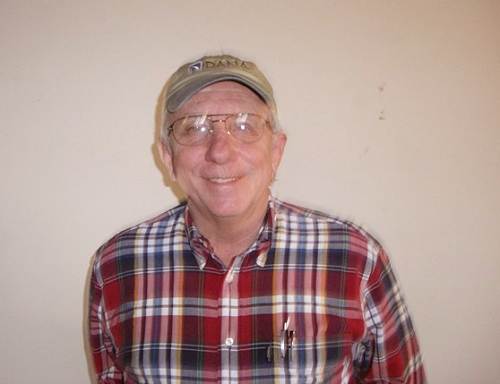
25 Wayne Johnson
Wayne is the one who, along with our director Nancy Thompson, sets up the
interesting designs of our web pages and manages the content of our web site. The day of
this visit Wayne was in his work clothes helping us with some revisions of the computer
equipment. In addition to these two, David Statler, also of Jefferson City, is the very
skilled person who assists me with the uploading of my contribution each week to the
President's Page (photo 26).
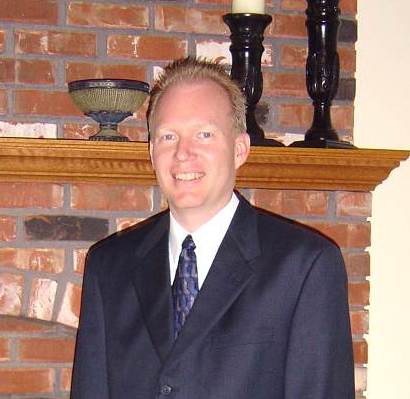
26 David Statler
We were pleased to host the Leadership Miller County group this week for a tour and
luncheon. This program is sponsored by the Missouri University Extension Division whose
director locally is Ted Fry (573 369 2394). The Extension office is located in Tuscumbia
on High Street just south of the old Courthouse. This week the group's meeting was given
lectures by Dan Gier (Miller County History) and Dwight Weaver (Highway 54 Corridor Eldon
to the Lake).
Work continues on the renovation of the old part of the museum. We anticipate opening
the museum in early May as usual although the full renovation will not be completed until
sometime after that.
That's all for this week.
| 


